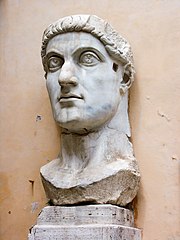This Day in World History
May 11, 330
Constantine dedicates Constantinople
Six years before, the emperor had ordered the building of a vast new city. On May 11, 330, construction was sufficiently complete for that city to be dedicated. The Emperor Constantine took part in a solemn mass at St. Eirene, his newly built church, that dedicated the new city to the Virgin Mary. He issued an edict that declared the city New Rome, or the Second Rome, capital of the empire. Within a hundred years, though, the city came to be known by another name — Constantinople.

Echoing the old Rome, the new capital was built on seven hills. A key new structure was the Milion, a monument that would serve as the point from which all imperial distances were measured. Crowning this structure was a holy relic — a piece of wood thought to be from the cross on which Jesus was crucified.
Constantine had an oval forum built entirely of marble. In its central plaza, he erected a 100-foot-tall porphyry column on a glittering marble base. Atop the column was placed a statue of the Greek god Apollo — his head replaced by a likeness of the emperor.
Constantine expanded the old hippodrome where chariot races were held and built an extensive palace as well. He also built stout walls, but these were eventually replaced, as his city swelled in population and needed to grow.
Thousands of workers had labored years to complete these buildings and to decorate them with treasures taken from sites around the Mediterranean. They enjoyed the forty days of festivities that followed the city’s dedication. Then they went back to work, finishing Constantine’s new capital.
“This Day in World History” is brought to you by USA Higher Education.
You can subscribe to these posts via RSS or receive them by email.



Recent Comments
There are currently no comments.